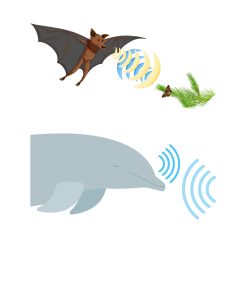As Halloween approaches, our minds often drift to the mysterious and the uncanny. Ghosts, goblins, and the occasional bat flit through our imaginations. But, what if we told you that some of the most fascinating creatures of the night aren’t just figments of spooky tales? Enter the world of bats and dolphins, two species that have a special superpower: sonar, also known as echolocation.
Echoes in the Dark: The Art of Echolocation

Echolocation is a biological sonar that allows creatures to see their surroundings, prey and predators by emitting sound waves and interpreting the echoes that bounce back. Imagine walking through a dark, haunted house with only your voice to guide you. As you call out, the walls respond, telling you where the corners are, if someone is lurking behind the door, and even the size of the room. This is essentially what bats and dolphins do, albeit with far more sophistication.
- Bats: Bats use echolocation primarily in the air. They emit high-frequency sound waves, which travel through the atmosphere. When these sound waves hit an object, they bounce back, allowing bats to determine the object’s distance, size, and shape.
- Dolphins: Dolphins utilize echolocation in water. They produce clicks, which travel efficiently through water. Similar to bats, they interpret the returning echoes to identify objects and navigate their environment.
For comparison, humans have been using sonar technology for over a century.
Echolocation Mechanics
How exactly does echolocation work?

- Bats: Bats have specialized ears and structures in their larynx to produce and detect echolocation calls. The sound is emitted through the mouth or nose, depending on the species. Their ears are highly sensitive to the frequency ranges they emit.
- Dolphins: Dolphins use their melon — a fatty structure located in their forehead — that focuses sound waves, allowing for precise echolocation. Their auditory systems are also highly adapted to detect the returning echoes, even in noisy underwater environments. The lower jaw’s cavities receive the echoes and send them to the middle ear. The auditory nerves send the echoes to the brain, where they are interpreted as an acoustic picture.

What’s particularly fascinating about echolocation in bats and dolphins is that it evolved independently in both species. According to a study in Current Biology, both mammals developed a nearly identical gene called prestin, which is essential for their high-frequency hearing and sonar abilities, despite their different environments. This research highlights a unique case of two distinct species following the same genetic path to develop a complex trait for echolocation, revealing similar mutations in the prestin gene in both animals.
(Read more about this research here).
So, now the question is, who do you think has the better sonar?
